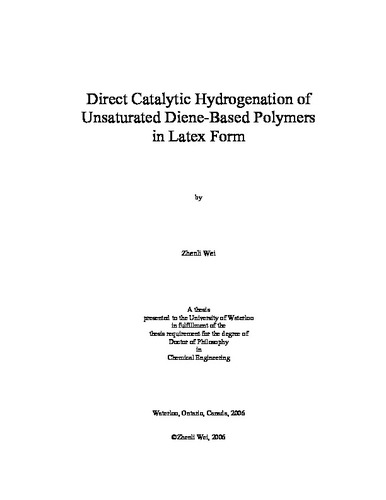| dc.description.abstract | The direct catalytic hydrogenation of nitrile butadiene rubber (NBR) in latex form was studied as a model system for the development of a new latex hydrogenation process for the modification of unsaturated diene-based polymers. NBR is a synthetic rubber of copolymerized acrylonitrile and
butadiene produced in latex form by emulsion polymerization. The catalytic hydrogenation of NBR is an important post-polymerization process resulting in a more stable and tougher derivative, hydrogenated NBR (HNBR), which has been widely used in the automotive and oil drilling industry.
The present commercial process involves a number of cumbersome steps to obtain solid NBR from the latex and subsequent dissolution of the solid NBR in a large amount of organic solvent followed by solvent recovery after coagulation of the hydrogenated NBR. Since NBR is produced in latex form, it is very desirable to directly hydrogenate NBR in the latex form which will significantly simplify the hydrogenation process and facilitate subsequent applications. As an economical and environmentally benign alternative to the commercial processes based on the hydrogenation of NBR in organic solution, this direct latex hydrogenation process is of special interest to industry. The objective of this project is to develop an efficient catalytic system in order to realize the direct catalytic hydrogenation of NBR in latex form.
OsHCl(CO)(O2)(PCy3)2 was initially used as the catalyst to investigate the possibility of hydrogenation of NBR in latex form and to understand the major factors which affect the hydrogenation operation. It was found that an organic solvent which is capable of dissolving or swelling the NBR was needed in a very small amount for the latex hydrogenation using the Os catalyst, and gel occurred in such a catalytic system during hydrogenation.
Wilkinson’s catalyst, RhCl(PPh3)3, was then used for the latex hydrogenation in the presence of a small amount of solvent successfully without gel formation. Further investigation found that Wilkinson’s catalyst has a high activity for NBR latex hydrogenation without the use of any organic
solvent. The influences of various operation conditions on hydrogenation rate, such as catalyst and polymer concentrations, latex system composition, agitation, reaction temperature and hydrogen
pressure, have been investigated. It was found that the addition of triphenylphosphine (TPP) has a critical effect for the hydrogenation of NBR latex, and the hydrogenation rate was mainly controlled by the amount of catalyst which diffused into the polymer particles. In the presence of TPP, NBR latex can be hydrogenated to more than 95% degree of hydrogenation after about 30 hours at 160oC using Wilkinson’s catalyst with a catalyst to NBR rubber ratio of 1 wt%, without the addition of any organic solvent. The apparent activation energy for such NBR latex hydrogenation over the temperature range of 152oC to 170oC was found to be 57.0 kJ/mol.
In the present study, it was also found that there are some impurities within the NBR latex which are detrimental to the hydrogenation reaction and are suspected to be water-soluble surfactant molecules. Deliberately designed solution hydrogenation experiments were conducted to study the impurity issue, and proper latex treatment methods have been found to purify the latex before hydrogenation.
To improve the hydrogenation rate and to optimize the latex hydrogenation system, water soluble RhCl(TPPMS)3 catalyst (TPPMS: monosulphonated-triphenylphosphine) was used for the latex hydrogenation of NBR. The latex hydrogenation using the water soluble catalyst with TPP can achieve more than 90% degree of hydrogenation within 20 hours at 160oC. Further experiments using
RhCl3 with TPP proved that the water soluble RhCl3 can be directly used as a catalyst precursor to generate the catalytic species in situ for the latex hydrogenation, and a stable NBR latex with 96% degree of hydrogenation can be produced without any gel problem within 19 hours of reaction at 160oC.
The catalyst mass transport processes for these Rh based catalysts in the latex system were investigated in order to further optimize the solvent-free latex hydrogenation process. While maintaining the emulsified state of the original latex, the direct catalytic hydrogenation of NBR latex can be carried out efficiently without any cross-linking problem to more than 92% degree of hydrogenation within 8 hours at 160oC.
As a result of this research project, new latex hydrogenation technologies were successfully developed to fulfill all major requirements for a solvent-free polymer latex hydrogenation route, which is a significant milestone for the improvement of this polymer modification technology. The
finding of TPP’s role as the “catalyst mass transfer promoter” is a breakthrough for the research field related to the hydrogenation of unsaturated diene-based polymers in latex form. | en |

